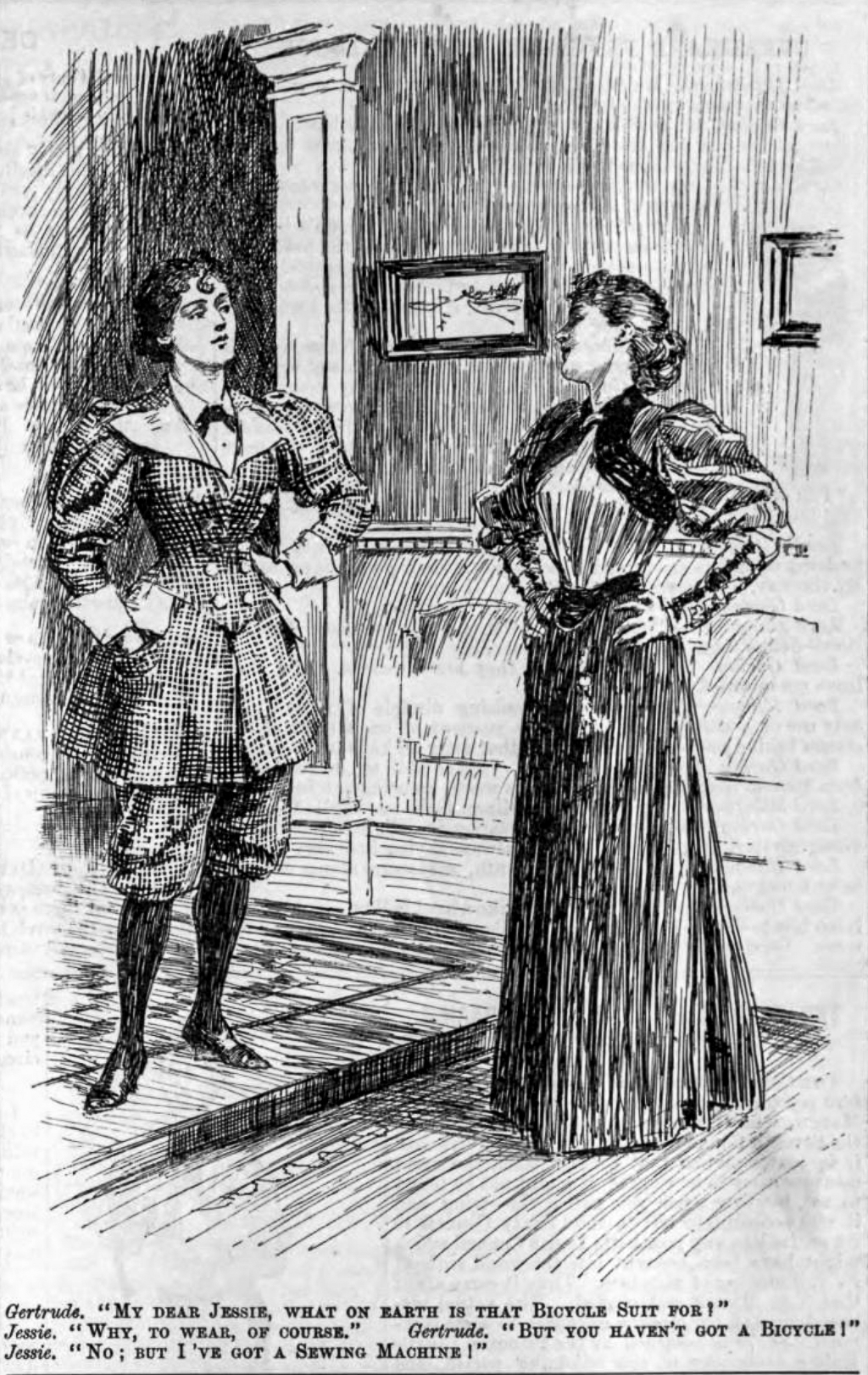|
Rational Dress Society
The Rational Dress Society was an organisation founded in 1881 in London, part of the movement for Victorian dress reform. It described its purpose thus: The Rational Dress Society protests against the introduction of any fashion in dress that either deforms the figure, impedes the movements of the body, or in any way tends to injure the health. It protests against the wearing of tightly-fitting corsets; of high-heeled shoes; of heavily-weighted skirts, as rendering healthy exercise almost impossible; and of all tie down cloaks or other garments impeding on the movements of the arms. It protests against crinolines or crinolettes of any kind as ugly and deforming... trequires all to be dressed healthily, comfortably, and beautifully, to seek what conduces to birth, comfort and beauty in our dress as a duty to ourselves and each other. In the catalogue of its inaugural exhibition, it listed the attributes of "perfect" dress as: Leading members of the Society were Lady Harberton ... [...More Info...] [...Related Items...] OR: [Wikipedia] [Google] [Baidu] |
National Dress Reform Association
National Dress Reform Association (NDRA) was an American association in support of the Victorian dress reform, founded in 1856 and dissolved in 1865. It was founded in February 1856 by the hydropathist James Caleb Jackson. Many of its members were hydropathists, who supported the Bloomers and a reform of women's dress for health reasons, and it was given support by many other health and sports organisations, from the contemporary women's movement, as well as by religious organisations who disliked fashion. The NDRA published information, arranged exhibitions and speeches. The campaign was given great publicity for the first couple of years after its foundation, and attracted members from almost every state. Lydia Sayer Hasbrouck Lydia Sayer Hasbrouck (December 20, 1827 – August 24, 1910) was an American hydrotherapist, an advocate for women's dress reform, and the founder and editor of ''The Sibyl'', a periodical devoted to that attire reform topic. Elected to the Midd ... ... [...More Info...] [...Related Items...] OR: [Wikipedia] [Google] [Baidu] |
Women's Health
Women's health differs from that of men in many unique ways. Women's health is an example of population health, where health is defined by the World Health Organization as "a state of complete physical, mental and social well-being and not merely the absence of disease or infirmity". Often treated as simply women's reproductive health, many groups argue for a broader definition pertaining to the overall health of women, better expressed as "The health of women". These differences are further exacerbated in developing countries where women, whose health includes both their risks and experiences, are further disadvantaged. Although women in industrialised countries have narrowed the gender gap in life expectancy and now live longer than men, in many areas of health they experience earlier and more severe disease with poorer outcomes. Gender remains an important social determinant of health, since women's health is influenced not just by their biology but also by conditions such ... [...More Info...] [...Related Items...] OR: [Wikipedia] [Google] [Baidu] |
Women's Rights By Country
A woman is an adult female human. Prior to adulthood, a female human is referred to as a girl (a female child or adolescent). The plural ''women'' is sometimes used in certain phrases such as "women's rights" to denote female humans regardless of age. Typically, women inherit a pair of X chromosomes, one from each parent, and are capable of pregnancy and giving birth from puberty until menopause. More generally, sex differentiation of the female fetus is governed by the lack of a present, or functioning, SRY-gene on either one of the respective sex chromosomes. Female anatomy is distinguished from male anatomy by the female reproductive system, which includes the ovaries, fallopian tubes, uterus, vagina, and vulva. A fully developed woman generally has a wider pelvis, broader hips, and larger breasts than an adult man. Women have significantly less facial and other body hair, have a higher body fat composition, and are on average shorter and less muscular than men. Thro ... [...More Info...] [...Related Items...] OR: [Wikipedia] [Google] [Baidu] |
Anti-fashion
Anti-fashion is an umbrella term for various styles of dress which are explicitly contrary to the fashion of the day. Anti-fashion styles may represent an attitude of indifference or may arise from political or practical goals which make fashion a secondary priority. The term is sometimes even used for styles championed by high-profile designers, when they encourage or create trends that do not follow the mainstream fashion of the time. Anti-fashion is considered radical creativity in apparel. It recombines a hodgepodge of details that dramatically alters current fashions. The newly transformed styles are later incorporated into the mainstream through media hype and commercial sales which reduce its stature. Grunge is an example of the oppositional style of dress while the rational dress of the Victorian era, which allowed ladies to swim or bicycle, is an example of a functional anti-fashion. Overview In discussing fashion and the nature of clothes, Lauer and Lauer discu ... [...More Info...] [...Related Items...] OR: [Wikipedia] [Google] [Baidu] |
History Of Clothing (Western Fashion)
The study of the history of clothing and textiles traces the development, use, and availability of clothing and textiles over human history. Clothing and textiles reflect the materials and technologies available in different civilizations at different times. The variety and distribution of clothing and textiles within a society reveal social customs and culture. The wearing of clothing is exclusively a human characteristic and is a feature of most human societies. There has always been some disagreement among scientists on when humans began wearing clothes, but studies involving the evolution of body lice suggest it started sometime around 170,000 years ago. Anthropologists believe that animal skins and vegetation were adapted into coverings as protection from cold, heat, and rain, especially as humans migrated to new climates. Textile history is almost as old as human civilization, and as time has passed, the history of textile has been more enriched. Silk weaving was introdu ... [...More Info...] [...Related Items...] OR: [Wikipedia] [Google] [Baidu] |
Clothing Controversies
Clothing (also known as clothes, apparel, and attire) are items worn on the body. Typically, clothing is made of fabrics or textiles, but over time it has included garments made from animal skin and other thin sheets of materials and natural products found in the environment, put together. The wearing of clothing is mostly restricted to human beings and is a feature of all human societies. The amount and type of clothing worn depends on gender, body type, social factors, and geographic considerations. Garments cover the body, footwear covers the feet, gloves cover the hands, while hats and headgear cover the head. Eyewear and jewelry are not generally considered items of clothing, but play an important role in fashion and clothing as costume. Clothing serves many purposes: it can serve as protection from the elements, rough surfaces, sharp stones, rash-causing plants, insect bites, by providing a barrier between the skin and the environment. Clothing can insulate against ... [...More Info...] [...Related Items...] OR: [Wikipedia] [Google] [Baidu] |
19th-century Fashion
The nineteenth century marks the period beginning January 1, 1801 and ends December 31, 1900. It was a period of dramatic change and rapid socio-cultural advancement, where society and culture are constantly changing with advancement of time. The ''Fashion of the 19th Century'' strongly reflected the technology, art, politics and culture of the time of which were highly influential to the styles and silhouettes. For women, fashion was an extravagant and extroverted display of the female silhouette with corset pinched waistlines, bustling full-skirts that flowed in and out of trend and decoratively embellished gowns. For men, three piece suits were tailored for usefulness in business as well as sporting activity. The fashion in this article includes styles from the 19th Century through a Western context - namely Europe and North America. Historical overview and fashions Early 1800s (1800-1829) Technological innovations At the turn of the 18th century, the Western worl ... [...More Info...] [...Related Items...] OR: [Wikipedia] [Google] [Baidu] |
Bicycling And Feminism
The bicycle had a significant impact on the lives of women in a variety of areas. The greatest impact the bicycle had on the societal role of women occurred in the 1890s during the bicycle craze that swept American and European society. During this time, the primary achievement the bicycle gained for the women's movement was that it gave women a greater amount of social mobility. The feminist Annie Londonderry accomplished her around-the-globe bicycle trip as the first woman in this time. Due to the price and the various payment plans offered by American bicycle companies, the bicycle was affordable to the majority of people. However, the bicycle impacted upper and middle class white women the most. This transformed their role in society from remaining in the private or domestic sphere as caregivers, wives, and mothers to one of greater public appearance and involvement in the community. Pre–bicycle craze cycling Before the 1890s, the bicycle was a vastly different vehicle an ... [...More Info...] [...Related Items...] OR: [Wikipedia] [Google] [Baidu] |
Svenska Drägtreformföreningen
Swedish Dress Reform Association (Swedish: ) was a Swedish women's association, active from 1886 to 1903.Jerremalm, Sanna (2010). Svenska reformdräkter : kvinnokläder för en ny tid. Uppsala: Uppsala Universitet, Textilvetenskap. Libris 13941878 It was a part of the Victorian dress reform, and worked to reform women's dress toward a more healthy and comfortable style, including abolishing the corset. The movement attracted a lot of attention and achieved some success during its duration, such as making corsets unfashionable among school girls. History Foundation The views of the Victorian dress reform were made known in Sweden by the book ''Dress and Health'', which was translated to Swedish under the name (likely by Oscara von Sydow) with an introduction by Curt Wallis and Hanna Winge. In February 1885, Anne Charlotte Leffler held a speech on the subject in the women's club Nya Idun, and asked Hanna Winge to design a Swedish reform dress; when this was done, Leffler becam ... [...More Info...] [...Related Items...] OR: [Wikipedia] [Google] [Baidu] |
Victorian Dress Reform
Victorian dress reform was an objective of the Victorian dress reform movement (also known as the rational dress movement) of the middle and late Victorian era, led by various reformers who proposed, designed, and wore clothing considered more practical and comfortable than the fashions of the time. Dress reformists were largely middle-class women involved in the first wave of feminism in the Western World, from the 1850s through the 1890s. The movement emerged in the Progressive Era along with calls for temperance, women's education, suffrage and moral purity. Dress reform called for emancipation from the "dictates of fashion", expressed a desire to "cover the limbs as well as the torso adequately," and promoted "rational dress". The movement had its greatest success in the reform of women's undergarments, which could be modified without exposing the wearer to social ridicule. Dress reformers were also influential in persuading women to adopt simplified garments for athletic ... [...More Info...] [...Related Items...] OR: [Wikipedia] [Google] [Baidu] |


.jpg)
.jpg)



_(14577452138).jpg)

